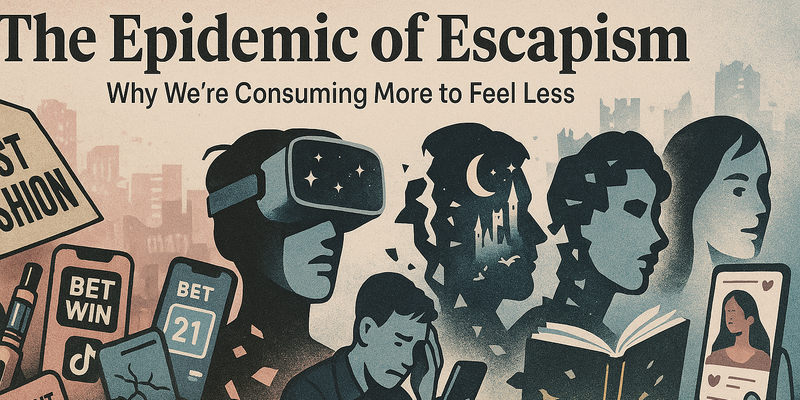
In today’s hyperconnected world, escapism has become more than a momentary distraction—it’s a lifestyle. Faced with economic precarity, social fragmentation, and political instability, many are opting for quick fixes to soothe their anxieties. From impulsive online shopping and fitness fads to parasocial relationships and gambling apps, consumer behaviour increasingly reflects our collective urge to flee rather than face reality.
Escapism is no longer about fantasy novels or weekend getaways. It now manifests as everyday spending patterns driven by the need to feel in control, even momentarily. This trend cuts across generations, income levels, and interests—making it one of the most defining cultural shifts of the 2020s.
From cigarettes to sea moss: Escapism just got rebranded
Historically, people coped with stress through cigarettes, alcohol, or gossip magazines. Today, we’ve rebranded those habits as “wellness.” Nicotine is back via vapes and Flum bars. Crash diets have morphed into bone broth, 75 Hard, and overpriced superfoods. The promise? A better life. The reality? Another form of consumption wrapped in virtue-signalling.
The rise of influencer-driven wellness culture encourages hyper-consumerism under the guise of health. Social media feeds are saturated with people promoting sea moss, hot girl walks, and boutique supplements—none of which address the root cause of personal dissatisfaction. Instead, they offer momentary relief and another reason to spend.
The cost-of-living crisis is fuelling the fire
It has never been more expensive just to survive. Since 2020, grocery prices have risen 25%, rent has increased by 40%, and nearly half of all U.S. adults are in credit card debt. Median home prices have skyrocketed to $420,000—far outpacing wage growth and inflation adjustments.
As traditional milestones like home ownership and financial stability drift out of reach, people seek emotional wins elsewhere. A $10 blind box toy or a $20 sports bet offers the kind of instant gratification that saving for a house simply can’t. This behavioural shift reveals a deep disillusionment with long-term planning in a world where the future feels increasingly inaccessible.
We’re building identities through what we buy
With fewer people able to own homes or build traditional wealth, consumerism has shifted toward symbolic ownership. Collecting toys like Sonny Angels, perfecting apartment aesthetics, or buying the latest TikTok trending items has become a way to assert control and identity. Fast fashion, micro-trends, and short-lived aesthetics create an illusion of personal expression while keeping consumers in a constant buying loop.
This endless cycle of trend adoption isn’t driven by genuine need—it’s driven by the need to feel part of something, to feel seen, and to reclaim agency in a world where agency feels scarce.
Escapism is emotional, not just economic
Beyond economic pressures, escapism is often rooted in emotional fatigue. Dating apps are surging, yet loneliness is at an all-time high. OnlyFans, fantasy franchises, and romanticised “soft life” trends are becoming emotional outlets, substituting community and connection with consumption and fantasy.
The culture of instant gratification is evident everywhere—from wellness fads to gambling apps and content bingeing. Each offers a temporary emotional boost, but leaves the underlying problems untouched. In most cases, these consumer habits not only fail to solve the problem but deepen the emotional and financial hole they aim to fill.
Marketing knows you’re tired—and it’s profiting from it
Escapist consumerism is not accidental. It’s a business model. Wellness brands, gambling platforms, fast fashion websites, and even media companies are all profiting from this emotional vulnerability. Products are sold as solutions to existential problems—sea moss for your skin, a new outfit for your self-worth, a bet to reclaim financial control.
When self-improvement becomes commodified, the goalpost keeps moving. You’re never “well” enough, stylish enough, or successful enough—because if you were, you’d stop buying. This is why escapism is endlessly monetisable: it promises relief, not resolution.
How do we break the cycle?
Escapism isn’t inherently bad—it’s a human response to stress. But when it becomes a substitute for progress, it keeps us stuck. So, how do we move forward?
- Acknowledge the consequences: Ask whether your current coping mechanism is solving the problem or merely delaying it.
- Build habits around connection: Join a workout group, co-work with friends, or start hobby circles to turn progress into a shared experience.
- Switch instant fixes for long-term systems: Choose sustainable investments over impulsive buys. Focus on creating routines, not just reactions.
Escapist consumption offers a comforting illusion in a world that feels increasingly out of control. But the more we buy to cope, the deeper we sink into a system designed to exploit that very urge. Escapism is profitable—for everyone except the consumer. And until we recognise the cycle, we’ll keep chasing comfort instead of change.
If history feels like it’s repeating itself, maybe it’s because we’re spending so much time escaping that we’ve forgotten how to confront.
Edited by Rahul Bansal

